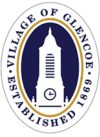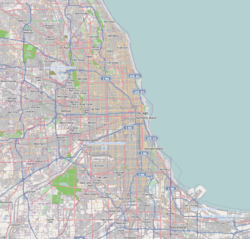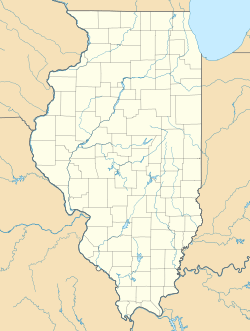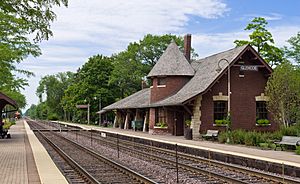Glencoe, Illinois facts for kids
Quick facts for kids
Glencoe, Illinois
|
||
|---|---|---|
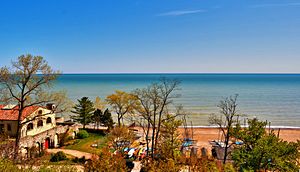
View of Lake Michigan
|
||
|
||
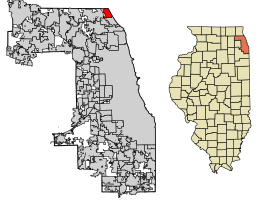
Location of Glencoe in Cook County, Illinois.
|
||
| Country | ||
| State | Illinois | |
| County | Cook | |
| Township | New Trier | |
| Incorporated | 1869 | |
| Government | ||
| • Type | Council-manager | |
| Area | ||
| • Total | 3.78 sq mi (9.79 km2) | |
| • Land | 3.72 sq mi (9.63 km2) | |
| • Water | 0.06 sq mi (0.16 km2) 1.59% | |
| Population
(2020)
|
||
| • Total | 8,849 | |
| • Density | 2,378.76/sq mi (918.9/km2) | |
| ZIP code(s) |
60022, 60093 (southeast corner), and 60062 (small commercial area in the southwest)
|
|
| Area code(s) | 847 and 224 | |
| Geocode | 29652 | |
| FIPS code | 17-29652 | |
Glencoe (/ˈɡlɛnˌkoʊ/) is a village located right on the shore of Lake Michigan in northeastern Cook County, Illinois, United States. In 2020, about 8,849 people lived there. Glencoe is part of Chicago's North Shore area and is known as one of the wealthiest communities in Illinois. In 2022, the average household income in Glencoe was $228,750.
Contents
History of Glencoe
The name "Glencoe" has a couple of possible origins. Some people think it was named after an early resident, Matthew Coe. Others believe it's named after a place in Scotland with the same name. The village started to grow in the late 1800s around a train stop. Walter S. Gurnee, a former mayor of Chicago, was in charge of the railroad line that connected Chicago and Milwaukee. He often bought land near train stops to develop it. One historian thinks the village might be named after Gurnee's wife, as he bought the land in 1867. The village's first official seal even looked like the seal of Glencoe, Scotland.
Famous Architecture
During the late 1800s and early 1900s, many beautiful homes were built in Glencoe. The village is especially famous for having the third-largest collection of buildings designed by the well-known architect Frank Lloyd Wright. His designs include seven houses, a concrete bridge, and three special markers in the Ravine Bluff area. There are also two larger homes he designed nearby. Other famous architects like Howard Van Doren Shaw, David Adler, and George Washington Maher also designed houses in Glencoe.
Community Development
Glencoe has had an African American population almost since it became a village in 1869. Many Black and Italian families lived in a five-block area near what is now Vernon Avenue. In 1920, the village decided to create a new park. To do this, the village acquired properties in this area to make space for the park.
In 1920, the African American community in Glencoe had 676 residents. By 1930, this number was 313, and in the 2000 census, it was 176.
Homer Wilson was the first Black person to own property in Glencoe. He used his home as a mortgage to help start the St. Paul AME Church, which is still an active church in Glencoe today. Glencoe's beaches were not open to everyone until 1942. That year, a court order allowed a Black family, A.L. Foster, his wife Mildred, and their two sons, to buy beach passes for the Park Avenue beach, which had previously been for white people only.
Glencoe has a "Village Manager" type of government. It was one of the first places to combine its police, fire, and paramedic services into one public safety department. In 1921, Glencoe created the first zoning code in Illinois, which helps decide how land can be used. The village's land-use plan from 1940 has mostly stayed the same. For example, the village used a law called eminent domain to acquire homes where Black and Italian residents lived to build a new park next to South School. The 1940 plan mainly set aside land for single-family homes, with no industrial areas. Glencoe has a small downtown area with basic services like a post office, library, Village Hall, a theater for performances, and a train station that goes to Chicago.
Geography of Glencoe
Glencoe covers about 3.78 square miles (9.79 square kilometers). Most of this area, about 3.72 square miles (9.63 square kilometers), is land, and a small part, 0.06 square miles (0.16 square kilometers), is water.
Glencoe is located on the western side of Lake Michigan. It is separated from other towns to the north and west by over 1,200 acres of natural forest area, which is part of the Cook County Forest Preserve. There are also three golf clubs that act as a buffer around the village: the Lake Shore Country Club to the north, the Glencoe Golf Club (run by the village) to the northwest, and the Skokie Country Club to the west.
The village is surrounded by other wealthy communities: Highland Park to the north, Northbrook to the west, and Winnetka to the south. The Skokie Lagoons, a series of connected waterways, are located in the forest preserve just west of the village. This forest preserve also has a bike trail that connects to other preserves to the south. Inside Glencoe, the Green Bay Trail allows bicyclists to ride south to Wilmette and north past Lake Forest. The highest point in Glencoe is about 690 feet (210 meters) above sea level, along Green Bay Road in the northern part of the village.
Southern Boundary Challenge
Glencoe shares its southern border with Winnetka, and this border actually cuts through 58 homes! This means that homeowners in these houses have to pay taxes to, and get permits from, both villages. The two villages started talking about this problem in the 1920s. In 2007, they reached a temporary agreement where each homeowner could choose which village they wanted services from, even though the official border didn't change. At first, 46 homeowners chose Winnetka, and others could decide later. The boundary was later updated to reflect these choices.
Education in Glencoe
Glencoe School District 35 is the elementary school district for Glencoe. All of its schools are located within the village.
For high school, Glencoe is part of the New Trier Township High School District. This district has two campuses: one in Northfield for freshmen (9th graders) and another in Winnetka for students in 10th through 12th grades.
Population and People
| Historical population | |||
|---|---|---|---|
| Census | Pop. | %± | |
| 1880 | 387 | — | |
| 1890 | 569 | 47.0% | |
| 1900 | 1,020 | 79.3% | |
| 1910 | 1,899 | 86.2% | |
| 1920 | 3,381 | 78.0% | |
| 1930 | 6,295 | 86.2% | |
| 1940 | 6,825 | 8.4% | |
| 1950 | 6,980 | 2.3% | |
| 1960 | 10,472 | 50.0% | |
| 1970 | 10,542 | 0.7% | |
| 1980 | 9,200 | −12.7% | |
| 1990 | 8,499 | −7.6% | |
| 2000 | 8,762 | 3.1% | |
| 2010 | 8,723 | −0.4% | |
| 2020 | 8,849 | 1.4% | |
| U.S. Decennial Census | |||
As of the 2020 census, Glencoe had 8,849 people living there, with 3,302 households and 2,563 families. The population density was about 2,341 people per square mile (918.9 per square kilometer).
The people living in Glencoe were mostly White (87.3%), with smaller percentages of Asian (4.3%), African American (1.0%), and other groups. About 4.2% of the population identified as Hispanic or Latino.
Out of the households, 38.5% had children under 18 living with them. Most households (69.96%) were married couples. The average household had 3.14 people.
The age breakdown of the village showed that 27.9% were under 18, 30.7% were between 45 and 64, and 21.5% were 65 or older. The average age was 47.2 years.
The median income for a household in Glencoe was $195,600, and for a family, it was $250,001. The average income per person in the village was $121,589, which makes Glencoe one of the 20 wealthiest communities in the United States.
| Race / Ethnicity (NH = Non-Hispanic) | Pop 2000 | Pop 2010 | Pop 2020 | % 2000 | % 2010 | % 2020 |
|---|---|---|---|---|---|---|
| White alone (NH) | 8,239 | 8,024 | 7,635 | 94.03% | 91.99% | 86.28% |
| Black or African American alone (NH) | 176 | 105 | 92 | 2.01% | 1.20% | 1.04% |
| Native American or Alaska Native alone (NH) | 4 | 5 | 8 | 0.05% | 0.06% | 0.09% |
| Asian alone (NH) | 147 | 234 | 377 | 1.68% | 2.68% | 4.26% |
| Pacific Islander alone (NH) | 0 | 1 | 0 | 0.00% | 0.01% | 0.00% |
| Other race alone (NH) | 9 | 13 | 38 | 0.10% | 0.15% | 0.43% |
| Mixed race or Multiracial (NH) | 79 | 109 | 327 | 0.90% | 1.25% | 3.70% |
| Hispanic or Latino (any race) | 108 | 232 | 372 | 1.23% | 2.66% | 4.20% |
| Total | 8,762 | 8,723 | 8,849 | 100.00% | 100.00% | 100.00% |
Arts and Culture in Glencoe
Points of Interest
- Chicago Botanic Garden
- Cook County Forest Preserves
- Frank Lloyd Wright-designed Sylvan Road Bridge (concrete) (designed in 1915)
- Frank Lloyd Wright-designed Ravine Bluffs Subdivision entry light/planter monuments at Sylvan/Franklin and at Franklin/Meadow (around 1915)
- North Shore Congregation Israel synagogue designed by Minoru Yamasaki
- Glencoe Metra station (built around 1891)
- Glencoe Sailing Beach
- Skokie Lagoons
- Am Shalom Synagogue
- St. Paul A.M.E. Church
- Writers Theatre
- Glencoe Historical Society
- Glencoe Beach
The Glencoe Public Library
Glencoe has its own public library. The first library was in the old Hawthorne School. A new, dedicated library building opened in 1941.
Media and Filming Locations
Local news about Glencoe can be found in The Glencoe Anchor, Winnetka-Glencoe Patch, TribLocal, and Pioneer Press. A company called The Free Press, which published social science books, started in Glencoe in 1947 before moving to New York City in 1960.
Glencoe on Screen
Glencoe has been a filming location for several movies and TV shows:
- Scenes from the popular films Ferris Bueller's Day Off and Sixteen Candles were filmed in Glencoe.
- The Glencoe train station appears in scenes from Flags of Our Fathers and She's Having a Baby.
- The 2011 movie Contagion also had scenes filmed in Glencoe.
Transportation in Glencoe
The Glencoe station offers Metra commuter train service. These trains travel south to the Ogilvie Transportation Center in Chicago and north to Kenosha station. Pace also provides bus service on Route 213, connecting Glencoe to other places across the North Shore area.
Notable People from Glencoe
Many interesting people have lived in or are from Glencoe:
- Curt Anderson - Maryland legislator, grew up in Glencoe.
- Michael Bloomfield - Blues musician, guitarist, and composer, lived in Glencoe.
- Leo Burnett - Famous advertising executive.
- Carl B. Camras - Ophthalmologist known for glaucoma research, born in Glencoe.
- Marshall Chess - Record producer, lived in Glencoe.
- Ann Compton - Former news reporter and White House correspondent for ABC News Radio, grew up in Glencoe.
- Douglas Conant - CEO of the Campbell Soup Company, grew up in Glencoe.
- Bruce Dern - Actor.
- Nick Foles - Quarterback for the Chicago Bears, lived in Glencoe from 2020 to 2022.
- Paris Grey - Singer, known for songs like "Big Fun" and "Good Life."
- Brian Griese - Quarterback for the Chicago Bears, lived in Glencoe briefly.
- Granville D. Hall - Early village clerk, journalist, and first Secretary of State of West Virginia.
- Rick Hahn - Chicago White Sox general manager, lives in Glencoe.
- Charles Henry Howard - Civil War General, head of the school board, and Village President (1891-1892).
- Walter Jacobson - Former Chicago TV news personality, grew up in Glencoe.
- Frank King - Cartoonist who created Gasoline Alley, lived in Glencoe.
- Eric Lefkofsky - Billionaire entrepreneur and co-founder of Groupon, lives in Glencoe.
- Zoe Levin - Actress, star of Bonding, moved to Glencoe at age 11.
- John Lippman - Television executive and acting director of Voice of America.
- Khalil Mack - Linebacker for the Chicago Bears, lived in Glencoe from 2018 to 2021.
- Archibald MacLeish - Poet and three-time Pulitzer Prize winner, born in Glencoe.
- Newton N. Minow - Former Chair of the Federal Communications Commission.
- Harold Ramis - Comedian, actor, and director (Ghostbusters, Groundhog Day).
- Betty Robinson - Olympic gold medalist and former fastest woman in the world, lived in Glencoe.
- Ben Savage - Actor (Boy Meets World), lived in Glencoe as a child.
- Fred Savage - Actor and director (The Wonder Years), lived in Glencoe as a child.
- Robert Shea - Co-author of the Illuminatus! trilogy.
- James Simpson Jr. - Member of the U.S. House of Representatives.
- Gene Siskel - Film critic and journalist for the Chicago Tribune.
- Ellen Spertus - Former research scientist at Google, grew up in Glencoe.
- Melville Elijah Stone - Newspaper publisher and founder of the Chicago Daily News.
- Kenneth S. Suslick - Leading expert on the effects of ultrasound, grew up in Glencoe.
- Lili Taylor - Actress (Mystic Pizza, Six Feet Under), born in Glencoe.
- Paul Thomas (director) (also known as Phil Toubus) - Actor and director.
- Mike Tomczak - Quarterback for the Chicago Bears, lived in Glencoe.
- Scott Turow - Bestselling author, lived in Glencoe.
- Peter Van de Graaff - Singer and radio personality, grew up in Glencoe.
- James Wilkerson - Senior Judge of the United States District Court for the Northern District of Illinois.
See also
 In Spanish: Glencoe (Illinois) para niños
In Spanish: Glencoe (Illinois) para niños


